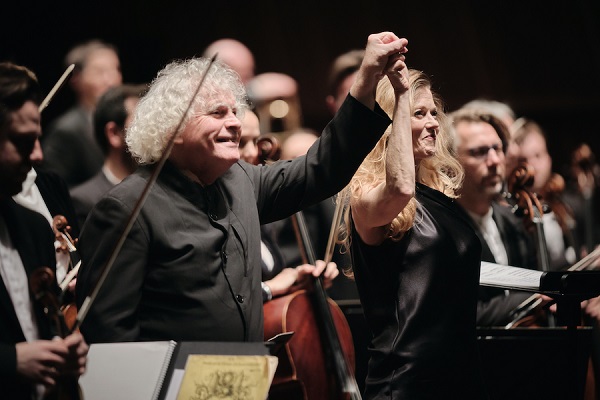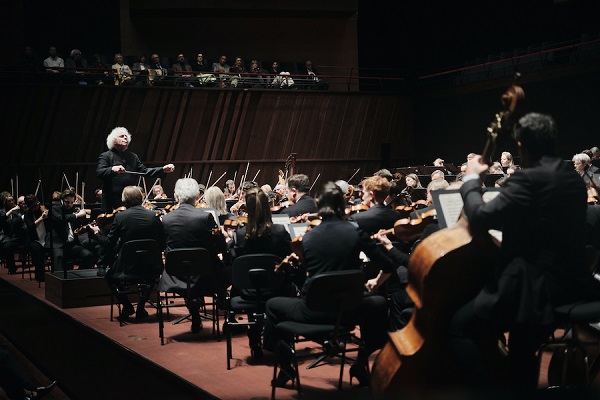 Sir Simon Rattle and Barbara Hannigan;
Credit: Eric Engel
Sir Simon Rattle and Barbara Hannigan;
Credit: Eric Engel
On Wednesday 15 January 2025, the Philharmonie Luxembourg welcomed Sir Simon Rattle and the London Symphony Orchestra to perform a selection of pieces chosen by the legendary conductor.
With the 70th birthday of the eminent English conductor fast approaching, there was much anticipation in the air before the first of Sir Simon Rattle’s two nights at Philharmonie Luxembourg.
Before the performers took to the stage it was evident that this would be a very grand occasion. The considerable stage of the Philharmonie was fully packed with seats and instruments, all useable space readied for the circa 100 players of the London Symphony Orchestra (LSO).
Yet, unexpectedly, the performance began with a sparse arrangement of only fifteen players spread out on stage. Sir Simon entered the hall to rapturous applause, acknowledging the crowd’s passionate welcome before taking his place on the conductors podium.
The opening composition (Éclat pour quinze instruments, by Pierre Boulez) featured a sparse, almost dissonant arrangement, serving as the amuse bouche for the evening’s menu. Like a chef selecting the finest ingredients, Rattle pinched, poked and prodded at the air as he playfully coaxed his musicians into serving up a touch of harp, a dusting of cello, a smattering of percussion and a measure of grand piano. It made for a surprising yet mesmerising beginning to the proceedings.
After a reconfiguration of the stage, seeing both the removal and addition of instruments, the main body of musicians from the LSO arrived. From here, the tempo rose for the next compositions (“Interludes” and “Aria” from Lessons in Love and Violence for soprano and orchestra, by George Benjamin) which saw the introduction of more brass and woodwind to complement the now expanded string sections. Cellos, violins and upright bass rose as Sir Simon playfully upped the energy. Oboe, clarinet and followed, with the brass section intertwining to create a voluminous sound which filled the Philharmonie. And then, from stage right, crept soprano Barbara Hannigan. Like a Hitchcockian femme fatale, she slowly wove her way through the packed musicians towards Rattle, arriving at the edge of the stage to deliver an unexpectedly tense and powerful performance which hypnotised the audience.
At this point it was obvious to all in the Grand Hall that Sir Simon was very much on form, his distinctive silver hair adding accent to his movements as he directed his musicians, his baton never resting as it whipped through the air.
After much applause and a brief intermission, during which the stage was again reconfigured, the Grand Hall was treated to a playful and stirring rendition of Johannes Brahm’s Symphony No.4 e-moli (mi mineur) op.98.
It was throughout these four movements that the woodwind and brass sections were given a true opportunity to shine, with the superb flute playing underpinned by vibrant timpani and boisterous strings. Despite being the longest running of the pieces performed on the evening, the energetic unfolding of this work was the highlight of the evening, with each section of the orchestra embracing the left-versus-right form of the melody, and Sir Simon Rattle pulling in every musician to craft a dynamic and bombastic wall of sound which floated above and beyond the orchestra.
Cue rapturous ovation from all of those in attendance and a wide-eyed smile from arguably one of the greatest conductors to grace the stage at Philharmonie. For his 70th birthday, Sir Simon Rattle had chosen to gift us.

(Pictured: The crowd takes in a packed stage at Philharmonie; Credit: Eric Engel)








